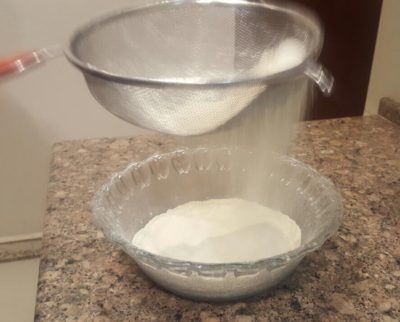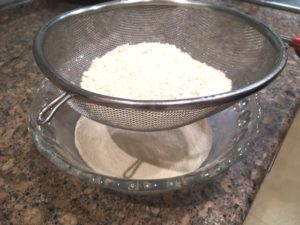What is the importance of sifting flour? What purpose does it solve? Is it important to sift flour?
If yes, what purpose does sifting solve? Whereas, if not, can it be avoided?
If such questions have ever bothered you then go through this post to clear all your doubts.
SIFT THE FLOUR
LIFT THE AIR

The Practice of Sifting Flour
I have seen my mom, granny, mom-in-law, aunts, everybody sifting the flour before kneading it to make chapatis. I am sure, you all must have experienced this some time or the other. It was a common practice in every household. However, it seems to be weaning away nowadays.
When I started cooking, I too blindly followed the practice as was told that chapatis come out soft and light by doing so. But had no clue as to what makes it soft and light. I somehow believed that it was done to remove impurities (bran) and lumps, if any, in the flour.
No doubt, this is one of the reasons behind sifting but when I entered the world of baking, I realized that there was much more to it.
While following the recipes to bake cakes, bread etc, I noticed that one step was common and that was to sift the flour at least 2-3 times.
Slowly and gradually, with practice, through reading and sharing with friends, I understood the science behind sifting.
What Is Meant By Sifting Flour?
Sifting, in fact, is a process through which air is incorporated into the flour, which in turn, makes the end-product light and fluffy, be it chapatis or cake or bread.
Through sifting, the flour becomes aerated.
Apart from this, there is one more reason for sifting and it is that ingredients like salt, baking powder, baking soda, cocoa powder, etc get mixed up evenly in the flour.
Nowadays, people are also using a fork or wire whisk for this purpose. It does solve the purpose to some extent but sifting undoubtedly gives excellent results.

To sum up, we can say the three purposes of sifting flour are:
- Remove impurities and lumps.
- Aeration.
- Even mixing of ingredients.
So please, if you want light n fluffy cakes n bread then don't underestimate the importance of sifting.
FAQs
Q) How to sift the flour?
- Use a strainer or sifter for sifting flour.
- Always sift flour from a height. It does make a difference. Try it yourself and share your views then.
Q) Sift flour before or after measuring?
While baking, first weigh/measure the flour, cocoa and other dry ingredients and then do the sifting. So, sift flour after measuring it.
Q) What will happen if you forgot to sift flour?
Since no air is incorporated in the flour, the baked goods will be heavy and dense.
Q) Does sifting flour increase its volume?
Yes! Though the weight remains the same but its volume increases as the flour is lighter now with a lot of air in it.
Q) How many times should the flour be sifted?
- The answer to this question depends on the goods to be baked as well as on the type of flour used.
- For cakes, all-purpose flour should be sifted at least thrice whereas, whole wheat flour needs to be sifted 4 to 5 times.
- Similarly, for muffins, sifting the flour just once is sufficient, though more the better.
- For baking cookies, one-time sifting is sufficient. This is just a basic idea. The best is to follow the recipe.
- Sift the flour as many times as the recipe asks for.
- Make it a routine to sift the flour at least once, whether it is whole wheat flour or all-purpose flour or any other. In fact, when baking with wheat flour, sift it 4 to 5 times to make it light.
Thus, Flour is sifted not just to remove impurities but is important as it makes the end product, be it chapati or cake or bread, light and fluffy by incorporating air into it.
I hope you have found this post on the importance of sifting flour useful and will always sift your flour now. And if already sifting then you know why you are sifting it.
Related Posts:
- Cake Baking Mistakes
- Tips for Baking a Good Cake
- Importance of Preheating
- Difference Between Baking Soda and Baking Powder
Thank you for reading this post. If you have liked this recipe then do let me know by leaving a comment below. Your feedback fuels my enthusiasm. You may share this post with your dear ones by clicking on the little buttons below. You may follow me on Facebook Pinterest Twitter Instagram(#samirasrecipediary) too. for latest recipe updates. Thank you!
Happy Baking...
Samira


Madam,
No confusion, direct explanation of science of sifting & it’s significance .
It is like a tutorial . Thank you .
Can you , please , explain difference between sifter and common household sieve , available in ss utensil shops.
Thank you so much for your kind words. Feels really nice to know that you liked it.
I use my simple household sieve only and am very happy with the results, be it baking or otherwise. Have never used a sifter, so can’t say how much better it is. But in my opinion, it’s just fancy equipment, you may add it to your kitchen just for a modern look and slightly more convenient sifting :)-
Comment this is so nice.. have really learnt a lot… thank you so much have really liked this post